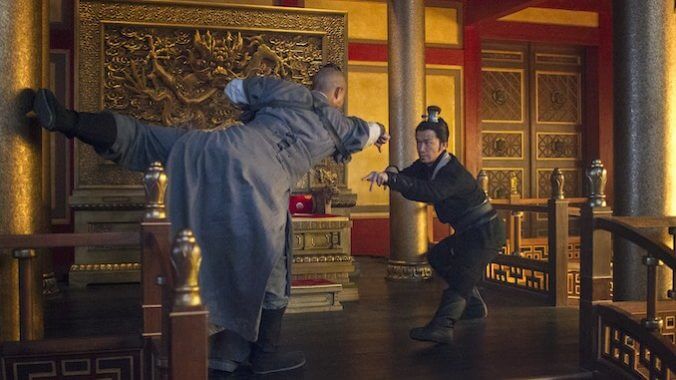How Netflix’s Extravagant Marco Polo Launched the Streaming Era—For Better or Worse
Photo Courtesy of Netflix
I want to look back at an older time. Not quite as old as 14th C. China but just as ancient in our collective memory. A time when streaming TV was a fresh concept and people were beginning to watch through the binge model. The entire entertainment industry was being turned upside down by the humble DVD mailing service Netflix. And they were about to make their biggest bet yet: turning the story of Marco Polo and Kublai Khan into the second most expensive TV show in history.
The story of Marco Polo the TV show begins in 2012. Writer John Fusco’s imagining of Marco Polo’s diaries had gotten picked up by Starz, but attempts to actually film the series failed. Enter the Weinstein Company, who offered to back the project (apparently because of Harvey Weinstein’s personal interest in Asian cinema). The series found a home in fledgling service Netflix, who sought a big-budget, attention-grabbing show to mark their entrance into the prestige TV space. They wanted a show with broad international appeal—an entirely new market since TV had previously been divided up by region throughout its history. Marco Polo was going to be Netflix’s answer to Game of Thrones, but even richer in historical detail. Game of Thrones was the most expensive series in history and a cultural juggernaut, so everyone wanted to copy its success. Netflix was going to show that the new kid in the entertainment landscape was capable of the same greatness.
Marco Polo producer Daniel Minahan pushed back against the Game of Thrones comparison in a 2014 interview with Uproxx. “The similarity is that there’s court intrigue [and] the scale of it, the idea that we were creating this big spectacle. But… that’s about it.” The team behind Marco Polo believed that they were getting to create a show unlike any other, backed by insane amounts of money and support from Netflix and the Weinstein Company.
But Marco Polo was not just a show for creator John Fusco. In 2007 he traveled the Silk Road with his son on camelback, immersing himself in the history he’d long studied. His son reminded him of Polo himself, a young boy traversing a foreign land. Throughout the journey the two experienced things “like broken ribs and running out of water.” Experiencing the land first-hand and connecting the past to the present fueled his desire to put the story of Marco Polo to screen. Fusco wrote “We would camp at night in the gers and I’d ask about the history of Mongolia and they would say: ‘Well, as Marco Polo said…’”

Designing Marco Polo was an exercise in history and imagination. No actual depictions of Kublai Khan’s court remain, so production designer Lilly Kilvert imagined the setting based on Kublai’s personal tastes and various Chinese, Arabic, and Tibetan influences. The show looks unlike anything else put to screen. Marco Polo also took great care in its fight choreography. The show takes inspiration from different kinds of martial arts, including wu xia and the works of the Shaw Brothers*. With the dedicated interest from Harvey Weinstein and Netflix looking to make a name for itself, Marco Polo was given everything needed to succeed.
*Stuntman Ju Kun was involved with the development of Marco Polo’s fight choreography alongside Breet Chan, but he disappeared on Malaysia Airlines flight MH370. My jaw dropped when I read this so you get to know it, too.
On December 12th, 2014, Marco Polo aired its entire first season on Netflix to dismal reviews. The show was criticized for being slow, boring, and a waste of viewer’s time. In his review for RoberEbert.com, Brian Tallerico called the show “Netflix’s derivative attempt to siphon some of the sizeable audience attracted to historical dramas.” While the performances were strong, especially Benedict Wong’s starring role as Kublai Khan, the overall reception was that Marco Polo was filled with characters no one cares about told without excitement or intrigue.
But Netflix’s attitude toward renewal was very different in 2014. Not only did Marco Polo get renewed, the show also received a Christmas special in 2015 about the best character: the blind monk martial arts master Hundred Eyes, played by an excellent Tom Wu. Then the show added Michelle Yeoh to the cast of Season 2. Netflix was not about to let Marco Polo fail.
Season 2 of Marco Polo is definitely an improvement. The show realized that the most boring part of Marco Polo is the titular character, so he is smartly sidelined in the second season to make way for more court drama and fight scenes. But even an always wonderful Michelle Yeoh was not enough to bring attention to Marco Polo or justify its high price tag.
In December 2016, five months after Season 2 aired, Netflix and TWC made the joint decision to cancel Marco Polo. This move was considered shocking at the time: Marco Polo became the first Netflix series to not get renewed for a third season. The Hollywood Reporter estimated a $200 million loss for the streamer. And with that, Netflix got a taste for the blood of a canceled TV show.
-

-

-

-

- Curated Home Page Articles By Test Admin October 21, 2025 | 3:10pm
-

- Curated Home Page Articles By Test Admin October 21, 2025 | 2:57pm
- Urls By Test Admin October 21, 2025 | 2:57pm
- Curated Home Page Articles By Test Admin October 21, 2025 | 2:55pm
-

-

-

-

-

-

-

-

-

-

-

-

-

-

-

-

-

-

-

-

-

-

-

-

-

-

-

-

-

-

-




































